PinotFile: 9.47 September 14, 2014
|
Minerality Lacks An Objective MeaningScott Rich, the proprietor (along with his spouse Marta) and winemaker of Talisman Wines in Sonoma, California, has me thinking about one of the most perplexing words in common wine parlance: minerality. I have also read a number of commentaries about minerality written by prominent wine writers of late. It seems like the more we know, the less we know about minerality, despite its common usage as a wine descriptor in wine reviews and discussions of terroir. Examples of mineral-based terminology abound. A recent review of 2012 Domaine Leflaive Batard Montrachet by Stephen Tanzer described the wine as “Quite full, rich and powerful, with a distinctly tactile quality to the saline, iodine and mineral flavors.” In another review by Tanzer of the 2012 Domaine Leflaive Chevalier Montrachet, he describes “a pungent vein of stony minerality running through the wine,” and refers to the wine’s “mineral tension.” The Burghound often mentions “mineral-inflected flavors” in his reviews of white Burgundy. Wine Spectator refers to “mineral aromas and flavors” and “a long aftertaste of stone” in a recent review of the 2011 Domaine Leflaive Puligny Clavoillon. The use of the word mineral in all its forms seems to be confined almost solely to white wines. For example, a Buying Guide from the Wine Enthusiast that included reviews of white and red Burgundy wines primarily from the 2010 vintage, had fifteen references to minerality among the white wine reviews and only two mentions of minerality among the more numerous red wine reviews. Until we can state for certainty what minerality in wine is, and are able to use science-based descriptors rather than general terms like “mineral aromas and flavors,” perhaps we should refrain from using the ambiguous word “mineral” altogether. Scott makes some astute points which I quote and paraphrase here. He says, “Much of the discussion about minerality has amused me because no one seems to be addressing the most obvious issue. That is, the term must be defined through standards so everyone is talking about the same thing, just like in the use of any other wine descriptor.” Scott, like many others of scientific leaning, wants a concrete (sic) definition of minerality established by standards that the wine community can agree upon.
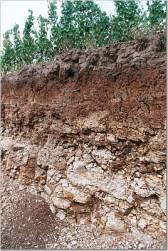 Noted winemaker and wine researcher, Clark Smith, thinks it is ‘indefinable,’ but attributes minerality to an ‘energetic buzz.’ Others think its not worth the effort to define, saying it is all bullshit. Robert Joseph wrote satirically (timatkin.com November 18, 2013), “Any scientist will tell you that there’s no granite or chalk in that wine. You ask a hundred people whether they want a mineral wine and there’s probably only two or three who’ve any idea what you’re talkin’ about.” Attempts to define minerality have led to widely diverse opinions. I would liken it to pornography: you can’t define it but you know it when you experience it. Scott notes that some perceive it as a ‘bright’ feeling in a wine, something some French tasters describe as ‘energetic.’ Others describe it as an aroma attribute, such as the smell of wet granite after a rain, and we all are familiar that smell, correct? It is also a general phrase that is used to describe wines that are not fruity, spicy or herbal. All that means, as Scott jokingly points out, is that the wine isn’t fruity, spice or herbal and the lack of these attributes does not by inference mean the wine has minerality. There are those who associate minerality with high acidity, but we know wines that are not high in acidity can seem to have minerality. Some have attributed minerality to volatile sulfur compounds in wine, also known as ‘reduction.’ Finally, people have used minerality to describe a mouthfeel or sensation, and although minerality may include this idea, that cannot be all there is to it. Here are some definitions of minerality that I have heard or read in the past few years: “A descriptor that reflects our struggle to find what we are experiencing.” Winemaker James Cahill “An effort to connect wine to the place it is grown.” Winemaker Fintan du Fresne “A way to describe the non-fruit components of wine. A word used to describe what one can’t describe plainly.” Winemaker Jason Jardine “A lack of fruit character in wine.” Winemaker Mike Waller. “A soil-based characteristic in wine.” Winemaker Jason Jardine. “I think of minerality as a wet-stone quality in a wine.” Winemaker Paul Draper. “The perception of geology in wine.” Dr. James Kennedy, California State University at Fresno “Something that exists but is not explainable. I know it when I taste it.” Writer Karen MacNeil. “Minerality is a complex mixture of compounds in wine which we associate with the smell of soils or rocky area.” Scientist Dr. Sue Ebeler, UC Davis. “Minerality is being able to actually taste the vineyard geology in the wine....in any literal way is scientifically impossible. Whatever minerality is, it is not the taste of vineyard minerals.” Alex Maltman, Institute of Geography and Earth Science, Wales. (see below for further discussion by Alex Maltman) “I can’t define minerality, but I know it when I feel it.” Writer Steve Heimoff. ”I suppose it is easier to define what it is not - that is, it is not fruit, nor acidity, nor tannins, nor oak, nor richness, nor fleshiness. It is not really a texture, either, for texture is in the middle of the palate and minerality is at the end. I think it is just there, a sort of lifted and lively stoniness that brings a sense of grip and a sense of depth, but it is neither grippy (which is tannin) nor deep (which is fruity).” Writer Stephen Spurrier (to Jamie Goode in The Science of Wine. “Wines richer in minerals present way differently. There is a suppression of obvious fruit....the wines seem to have a sort of nucleus or density around their ether. They are gathered, focused, cohered the way a laser coheres light.” Winemaker Randall Grahm. “Minerality is a concept which could never be consistently defined in words or physical standards.” Sensory chemist Dr. Ann Noble. “The minerality of a wine is experienced like a generation of tension in the mouth that is innately refreshing and energizing.” Winemaker Jason Lett. “Minerality is more of a sensation than a flavor that predominantly appears in an elusive finish.” Winemaker Steve Matthiasson. “Minerality is the aroma, taste and tactile sensation in wine when grapes are grown on rocks.” Winegrower Kevin Harvey. “Minerality or mineral-driven wines are those that are not highlighted by oak regimen or fruitiness but by soil flavors and stoniness. When it applies to white wines, it means low alcohol, high acid and freshness.” Sommelier Mike Madrigale (The SOMM Journal Aug/Sept 2014). “Minerality to me is non-fruit and non-oak descriptors for a wine - things like chalk, crushed seashells, gravel, gun flint, a sidewalk after a light rain. I feel like when people run out of descriptors for a wine, after they’ve named all the fruit and herbs, they often say “minerality’ instead of really defining what that minerality is.” Sommelier Jeff Taylor (The SOMM Journal Aug/Sept 2014). “Minerality is one of the more important components of a great wine. That said, it is one of the more difficult terms to define. To me, wine with a lifted finish, bright acidity and a notion of saltiness can be said to possess minerality. Beyond that, a difficult-to-pinpoint characteristic of great ‘drinkability’ always goes hand-in-hand with wines of minerality. We, as an industry, need to pinpoint the important aspects of (it) and share it with our guests.” Sommelier Eduardo Port Carreiro (The SOMM Journal Aug/Sept 2014). “Minerality is a fashionable word never employed in the 1970s and 1980s. The only no-nonsense use is to describe a wine marked by salty and mineral undertones balancing the fruit, more often a white wine rich in calcium and magnesium as many mineral waters are. For a red wine I have no idea.” Writer Michael Bettane (to Jamie Goode in The Science of Wine). “Minerality, although a useful term for conveying suggestions of flavors, textures and aromas, should not be taken literally. As several geologists have stressed to me, vine roots simply are incapable of extracting aromatic compounds from hard rock, let alone transporting them directly to grapes. That’s just not the way plants grow, despite romantic wine geek notions to the contrary. The mineral content in wine is well below the threshold of human perception. Stone in wine? It’s blarney.” Writer Beppi Crosariol (The Globe and Mail, Canada, online). “While the concept of minerality should not be taken literally in trying to analyze, quantify and scientifically explain a wine’s character and quality, the terms and its related forms such as ‘stony,’ flinty,’ ‘chalky,’ etc., remain valid and at times very useful words in the winetaster’s lexicon.” Writer Stephen Eliot (Connoisseur’s Guide to California Wine, May 2014). “Minerality is a sense of mineral-ness in the wine, including flavors of slate, schist, silex, etc.” Wikipedia.
One of the most thorough scientific discussions of minerality appeared in the wine blog, ‘Wine-Mise en abyme’ (“Minerality in wine? Fuggedaboudit,” June 18, 2013) at www.mowse.blogspot.com/2013/06. This post summarized the work of Alex Maltman of the Institute of Geography and Earth Sciences, Aberystwyth University, Wales. Maltman has pointed out that the term ‘minerality‘ is a contemporary invention that has no basis in science-based tasting schemes. Maltman’s article that appeared in the Journal of Wine Research in 2013 is heavily quoted in this post. The amount of nutrient ions absorbed by the vine roots is not directly related to the amount of nutrient ions in the soil. Maltman notes, “The proportion of mineral nutrients in finished wine bears only a complex, indirect, and distant relationship with geological minerals in the vineyard.” Maltman argues that minerality cannot be tasted in wine. He further states that the concentration of inorganic material and mineral elements, in particular, in wine is minuscule, and these mineral elements have no flavor. Only sodium chloride among all the minerals produces a flavor in the mouth. Scott first met with the issue of minerality in 1989 when he was Clark Smith’s research enologist at R.H. Phillips Vineyard. The job involved many vineyard-based and winery-based experiments. Many of the experimental results were validated using tasting panels and statistical methods to determine the significance in differences found among experimental treatments. In order for the tasting panels to have a common vocabulary, flavor and aroma standards were prepared so that all terms were clearly defined and all tasters knew precisely what each descriptive term meant. Scott told me, “One of the most interesting standards was for a Semillon that we felt possessed the aroma of wet granite after a rainstorm. I prepared a standard for this descriptor by pouring distilled water over a piece of granite, recovering the water, and repeating the process until the essence was noticeable in the water. Scott has taken an early step in establishing standards for minerality descriptors. He sent me four minerality standards: Squaw Valley granite, Mt. Harlan limestone, Sonoma Mountain basalt, and Lodi gravel. They were prepared by crushing pieces of each rock and soaking them in a solution of 30% Sky vodka which is the most neutral as determined by a blind vodka tasting, and 70% distilled water for a couple of weeks. The solution was then filtered through a 0.45 micron disk filter with the solution delivered via syringe to remove any heavy metals or other toxins associated with the minerals. I only evaluated the aromas (blind) of the sample liquids and did not drink them. My impressions were similar to Scott’s: Sonoma Mountain basalt: wet mud, wet terra cotta, wet clay, earth Squaw Valley granite: very subtle steely, stainless steel impression Lodi gravel: similar to Squaw Valley granite, primarily smelled like mineral water Mt. Harlan limestone: distinctive aromas of cement, dirt, earth, clay and grass Considering these preliminary results, Scott feels that there needs to be an expanded aroma wheel (an addition to Ann Noble’s aroma wheel) or a new one to address minerality, and he might begin work on the challenge. Read Scott’s up close and personal feature at the end of this issue.
Australia Pinot Noir Needs No BushEvery wine drinker with even rudimentary wine knowledge can recite the popular and noble varietals of Australia that include Shiraz, Cabernet Sauvignon, Semillon, Riesling, Chardonnay and “stickies” (Tokay and Muscat), but few know of or have even tasted Australian Pinot Noir. Although 60% of Australian wine is exported, the small production of Australian Pinot Noir is eagerly consumed by the country’s insatiable wine drinkers and very little ever reaches our shores. About 50% of all Pinot Noir produced in Australia is sold directly to consumers at wineries’ tasting rooms (called “cellar doors” in Australia) or through a mailing list, with the balance evenly divided between restaurants and wine retailers. Pinot Noir has been grown in Australia since 1834 when plantings were established in southeast Australia (southern Victoria) using cuttings brought to the region from Tasmania. By 1890, Victoria produced more than 50% of Australia’s wine, with some of the annual output blended and shipped abroad under the name of “Australian Burgundy.” Phylloxera devastated the wine industry by 1920, and recovery was led by fortified wines and plantings of classic French varieties in the 1970s and 1980s. Sporadic successes with Pinot Noir appeared in the 1970s, but some plantings were situated in warmer climate sites resulting in wines with stewed flavors that mirrored the early experience with Pinot Noir in the United States. With time, several iconic Australia Pinot Noir wineries emerged including Bannockburn, Bass Phillip, Bindi and Giaconda, all of which were located in the cooler microclimates of Victoria, particularly in the regions in the “Dress Circle” of Melbourne, including Geelong, Macedon Ranges, and South Gippsland. Several prominent Pinot Noir produces also gained notoriety in the Mornington Peninsula, the most southerly region for Pinot Noir in Victoria, where plantings were first established in the 1980s.
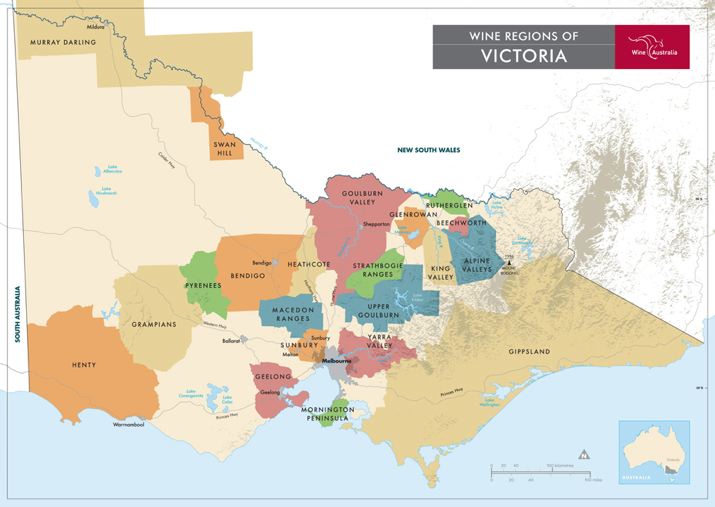 The Mornington Peninsula growing region is of special interest because the area’s unique maritime climate is similar to Burgundy’s humid climate, providing an extended autumn with a relatively late harvest so that grapes ripen fully with high natural acidity and fine tannins. The Mornington Peninsula is surrounded by water resulting in relatively high summer humidity. The vineyards benefit from low vine stress, abundant sunshine hours, and plentiful rainfall during the winter and spring (growing season rainfall is 12.5-15.2 inches). Heat degree days from October to April are 1080-1570. Today, the Mornington Peninsula has more than 200 vineyards, most of which are less than 10 acres, and over 50 wineries with cellar doors. Although Chardonnay, Pinot Gris and Shiraz have a small presence, Pinot Noir is the Mornington Peninsula’s signature wine. The Victoria region is the largest producer of Australian Pinot Noir by far, with the Mornington Peninsula having the most Pinot Noir vineyard acreage at about 2,300 acres. and annual production of about 160,000 cases (depending on vintage). In Australia, there are 16 significant clones of Pinot Noir planted, most on their own roots. The most common clone is one unique to Australia known as the “Mother Clone,” and designated MV6. It is said to have come from Clos Vougeot, and has a floppy canopy, small bunches and berries, concentrated plumy and meaty characters, and very good structure. It performs well as a stand-alone clone as well as a foundation clone in blends. Other clones include D2V5 (UC Davis origin, aka Wädenswil or UCD 1A), D5V12 (UC Davis origin, aka UCD 20), GSV15 (UC Davis origin, aka D2V6), G8V7 (UC Davis origin, aka UCD 15), H7V15 (UC Davis origin, aka UCD 22), 8048 (UC Davis origin, aka Wädenswil or UCD 2A), G8V3 (UC Davis/Swiss origin, aka UCD 14), Mariafeld (UC Davis/Swiss origin, aka UCD 23), 18GM (German origin, aka UCD 13), Pommard (UC Davis origin, aka UCD 5 and UCD 6), and Dijon clones 114, 115, 386, 521, 667, 777 and “828” (UC Davis/ Dijon Burgundy origin). The Davis clones were used in many of the early Pinot Noir vineyards, while the Dijon clones make up most of the newer plantings. Trellising is most often vertical shoot (VSP), although quite a few growers use some form of Lyre or Scott- Henry. Most vineyards yield between 2 and 3 tons per acre. Very little irrigation is used once the vines are established to promote deep root systems and the roots can go very deep. With small producers, most of the vineyard work is hands-on by the owners who perform pruning, trimming, leaf pulling, shoot thinning and spraying, while teams of Asian immigrants farm larger vineyards. Few producers use biodynamic principles. Harvest runs from the end of March to early June annually. Richard McIntyre of Moorooduc Estate defined the typicality of Pinot Noir from the Mornington Peninsula. “There are two main unofficial sub regions of the Mornington Peninsula. The more northerly sub region (“down the hill”) is warmer and drier with poorer, soils, and the more southerly sub region (“up the hill”) is at a higher altitude and cooler. The best wines from both sub regions have complex aromatics, good mid palate weight and length and fine tannins. The primary fruit aromas and flavors are in the spectrum of cherries, raspberries and plums with the “up the hill” wines tending to red fruits and the “down the hill” wines to darker fruits. Savoury complexity is common, and as vine age increases, we are seeing more tannic structure in the wines, to an unusual degree for new world Pinot Noir. In terms of longevity, the almost universal use of screwcap closures do not allow the ingress of significant amounts of air into bottles, meaning there is virtually no inconsistency and premature oxidation of the wines. One would expect the more recent Pinot Noirs to live ten to fifteen years.” A map of the Mornington Peninsula with soil types and locations of several of the wineries whose Pinot Noirs are reviewed in this issue follows (available for download at www.mpva.com.au). Soils are mainly either sedimentary or volcanic basaltic, the latter holding water much better and eliminating the need for irrigation. As you can see from the map, the “Down the Hill” more northerly region has primarily sedimentary soils and the “Up the Hill” more southerly region has mainly volcanic soils.
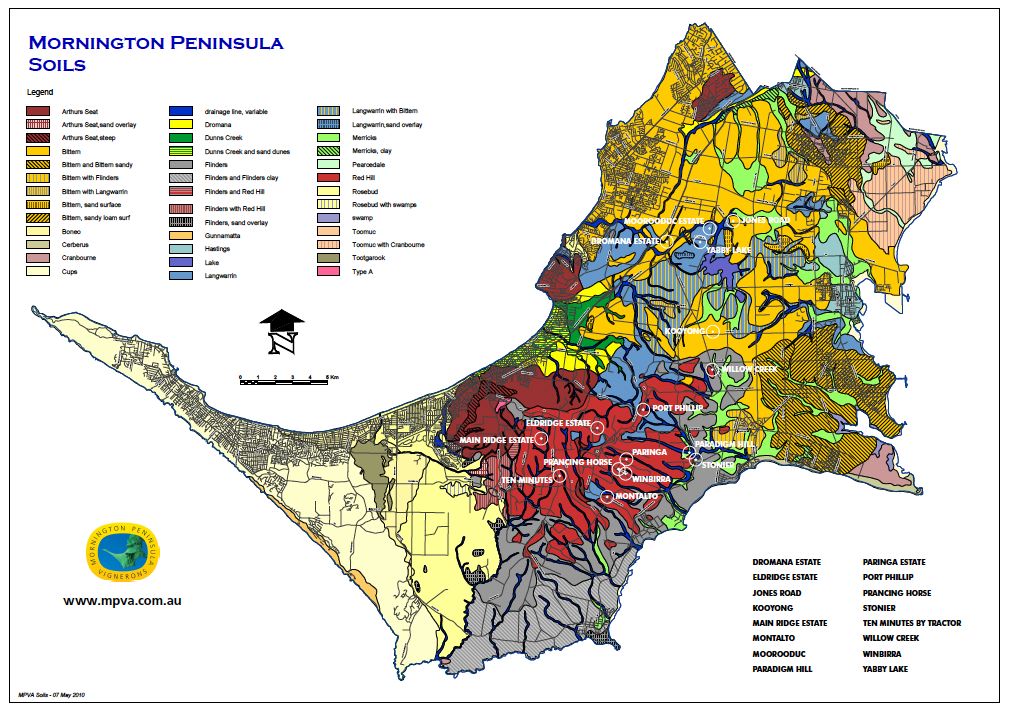 The biggest challenges to growing Pinot Noir in Victoria are birds (netting is required), cool snap at flowering causing poor fruit set, frost in some areas, and rain at harvest. A concern is the uncertainty about climate change. The climate in recent years has been warmer than ten to fifteen years ago which has improved wine quality, yet further significant warming could be problematic. Winemaking in the Mornington Peninsula is traditional with most vintners using the same de-stemmer that allows whole berry fermentation. Both air bag and hydraulic basket presses are employed. Most wines are made from de-stemmed grapes although small amounts of whole cluster are added to some wines. Fermentation is usually with indigenous yeasts and is carried out in stainless steel or plastic open top vats. Elevage is in French oak barrels of which about 30% are usually new and from multiple coopers (Kooyong uses only Francois Frères). About half the vintners inoculate for malolactic fermentation in barrel. Most wineries use mobile bottling lines. My good friend, David Lloyd, the proprietor and winemaker of Eldridge Estate in the Red Hill region of the Mornington Peninsula, collected a baker’s dozen of 2012 Pinot Noirs from the Mornington Peninsula region and we tasted most of the wines together recently while he was visiting the United States (note the photo below). The 2012 vintage was comfortable for growers who experienced little disease pressure. James Halliday, noted Australian wine critic, said, “I cannot remember a vintage having received such hyperbolic praise right across the board, covering all regions and all varieties, as there is for 2012. The only sour note is the low yields, seldom less than 20% below average, and for some half of the average.” In the Mornington Peninsula harvest occurred from late February to early April in 2012. David points out, “We have a large number of vineyards in a relatively small region that show a large diversity of wine styles due to their location and soil type.” Our tasting of the 2012 Pinot Noirs did reveal some overall consistency with the wines exhibiting a richness of fruit, evident tannins ranging from mild (“lovely” was David’s term) to muscular (“rippy” was David’s term). There was often a savory component, oak was rarely prominent, balance was usually impressive, and the wines evolved beautifully over time in the glass. Some of the wines showed more effusive aromas and flavors after a day or two from previously opened and re-closed bottles indicating they will have significant longevity. All wines have screwcap closure except Hurley Vineyard (DIAM cork). Overall, the wines were gnarly. Many of the wines have been released in the past 3 months. Retail prices range from $40 to $70 American dollars. Very small amounts of Bass Phillip, Bindi, Eldridge Estate, Giaconda, Kooyong, Moorooduc Estate, Paradigm Hill and Yabby Lake are exported to the United States. The Mornington Peninsula has its own International Pinot Noir Celebration modeled after Oregon's International Pinot Noir Festival. The next Mornington Peninsula International Pinot Noir Celebration will be held February 6-7, 2015, at RACV Cape Schanck. The keynote speaker will be Tim Atkin MW. The event includes two days of tasting Pinot Noir as well as lunches and dinners at various wineries, and a program of activities in the days pre and post Celebration. For information, visit www.mpva.com.au. “Down the Hill”
2012 Hurley Vineyard Garamond Mornington Peninsula Australia Pinot Noir 13.9% alc.. Sourced from the 3-acre Garamond Vineyard planted to clone MV6. Aged 18 months in 33% new French oak barrels. Bottled unfined and unfiltered. Winemaker is Kevin Bell. · Very light garnet color in the glass. Aromas and flavors of strawberry, cherry and cranberry with herbs in the background. Good mid palate intensity and length with some finishing delight. A delicate wine with soft tannins and easy drink ability. Score: 89
2012 Kooyong Ferrous Mornington Peninsula Australia Pinot Noir 13.5% alc.. Port Phillip Estate was established in 1995 by Chris and Gail Aylward. It’s Kooyong wines come exclusively from the estate’s 52 acres of Pinot Noir (8 clones) and 27 acres of Chardonnay (10 clones). The Pinot Noir offerings include an Estate wine, and three single vineyard bottlings: Ferrous, Haven and Meres. The winemaker is Sandro Mosele. · Moderate reddish purple color in the glass. The most distinctive wine in the lineup with aromas of dark cherry pie glaze, forest floor and oak. The mid weight flavors of very ripe dark cherry and purple stone fruits are clothed in oak, with an underpinning of iron-driven minerality. The wine sports admirable elegance with well proportioned dry tannins and some finishing fruit goodness. Score: 89
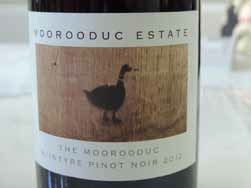 2012 Moorooduc Estate The Moorooduc McIntyre Mornington Peninsula Australia Pinot Noir 14.0% alc.. Established in 1982 by Richard and Jill McIntyre. A selection of the best clones in the home vineyard. Only made in years when the fruit is of high enough quality to represent the pinnacle of quality from Moorooduc Estate and Richard McIntyre’s skills. Assistant winemaker is Jeremy Maygar. · Moderately light garnet color in the glass. Appealing aromas of raspberry, plum, underbrush, spice and iron, becoming more effusive over time in the glass. Plenty of spicy and very ripe raspberry flavor picks up intensity over time. The fruit is wrapped in fine-grain tannins and backed by lively acidity. An earthy, iron flavor riff adds interest. Score: 91
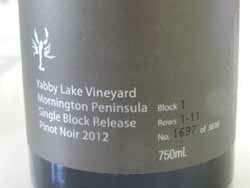 2012 Yabby Lake Vineyard Single Block Release Mornington Peninsula Australia Pinot Noir 13.5% alc., 320 cases. From Block 1, Rows 1-11 planted in 1998 to low-yielding MV6 clone. Soil is sandy clay loam. Grapes are 100% de-stemmed, spend 14 days on skins. Significant proportion of whole cluster. Winemaker is Tom Carson. · Moderately dark reddish purple color in the glass. Aromas of cherry, underbrush and dried rose petal lead to a mid to full bodied core of black cherry and black raspberry fruits wrapped in firm tannins. Impressive mid palate attack and finish but seems a bit closed. Much better when tasted two days later from a previously opened and re-closed bottle with more aromatic vibrancy and more expressive fruit. This wine has the most tannin in this lineup, presumably from the large percentage of whole cluster, and will need a few years in the cellar to reach nirvana. Score: 93
2012 Willow Creek Vineyard Mornington Peninsula Australia Pinot Noir 13.0% alc.. Clones D2V5, D5V12, 115, MV6, and 777. Soils is sandy loams and red volcanic clay. Yield 1 ton per acre. Aged in 25% new French oak barrels. Winemaker is Geraldine McFaul. · Moderately light reddish purple color in the glass. This is a cherry-driven wine with accents of dark raspberry, sarsaparilla, briar and rose petal. Light to mid weight and very elegant, with well-managed, dry tannins. This is a very comforting wine that held up nicely over two days after opening. Score: 90
“Up the Hill”
2012 Ten Minutes by Tractor Judd Mornington Peninsula Australia Pinot Noir 13.5% alc., 225 cases. Originally started by three family owned vineyards that were 10 minutes apart by tractor. A relatively warm site with a steep and high vineyard location. Four clones first planted in 1997. Record veraison to harvest interval (70 days compared to an average of 57 days). 20 days on skins, aged 14 months in new and used French oak barrels. Winemaker is Martin Spedding and assistant winemaker is Jeremy Maygar. · Moderate reddish purple color in the glass. Aromas of black raspberry, black plum, rose petal and stalk. Plenty of power and length on the mid palate with impressive finishing intensity. The flavors of black raspberry, black currant and plum reflect a warmer site. The wine has good harmony with balanced tannins, a silky mouthfeel, and a lengthy, generous finish. Score: 90
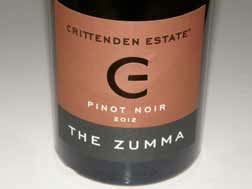 2012 Crittenden Estate The Zumma Mornington Peninsula Australia Pinot Noir 13.7% alc.. This a small family owned winery. Gary Crittenden was one of the first to plant grapevines in the region in 1982. The Zumma name was adopted by the family’s 27-acre farm (now vineyard) when purchased in 1981. This limited bottling is sourced from the estate’s oldest vineyard plantings. Wild yeast fermentation, bottled unfined and unfiltered. · This is clearly a special wine from the moment the cork is pulled. Moderately light reddish purple color in the glass. The aromatics are engaging and persistent featuring aromas of cherry, spice and a subtle hint of oak. The delicious mid weight core of cherry, cranberry and raspberry fruits make an impression on the mid palate and deliver a long and generous finish. Soft in the mouth with integrated tannins, the wine holds up nicely over time in the glass. A very giving wine that aims to please. Still enticing later in the day from a previously opened and re-closed bottle. Score: 93-94
2012 Eldridge Estate Mornington Peninsula Australia Pinot Noir 13.5% alc.. One of the coolest and oldest vineyards in the Mornington Peninsula with vines dating back to 1984. Owner and winemaker David Lloyd is dubbed the “Clone Ranger” in Australia for his research on clones of Pinot Noir. 7 acres of Pinot Noir (6 clones) and Chardonnay (5 clones). This wine is darker than usual in this vintage. 10% whole cluster. · Moderately light reddish purple color in the glass. Endearing aromas of cherry, brown spice and vanilla picking up intensity over time in the glass. The middleweight flavors of dark cherry and raspberry are vivid and expansive, finishing with noticeable verve and length. The oak is complimentary but could benefit from more time to fully integrate The suave, suede-like tannins are nicely balanced. Even better the following day from a previously opened and re-closed bottle. Score: 93
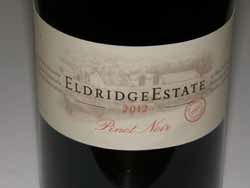 2012 Eldridge Estate Single Clone MPV6 Mornington Peninsula Australia Pinot Noir 13.5% alc.. · Moderate reddish purple color in the glass. This wonderful wine is showing a modest oak sheen that will integrate over time. The nose offers aromas of cherry, sandalwood, spice and sweet oak. Impressive fullness and richness on the palate that features discreetly concentrated flavors of black cherry, blackberry and plum. Soft, even velvety in the mouth, with a richly fruited, very long finish. Hard to resist now, this gorgeous Pinot Noir will benefit from a few years in the cellar. Score: 93-94
2012 Main Ridge Estate Half Acre Mornington Peninsula Australia Pinot Noir 13.5% alc.. A pioneering wine estate established in 1975 and granted the first commercial winery license on the Mornington Peninsula in 1978. The vineyard was developed completely by hand, meaning owners Nat and Rosalie White dug every post and vine hole. The vineyard is primarily Pinot Noir and Chardonnay. Two Pinot Noir wines, “The Acre” and “Half Acre” are produced. The winemaker is Nat White. · Moderately light garnet color in the glass. Pleasant aromas of fresh cherry coulis leading to savory mid weight flavors of fresh cherries. The tight knit tannins provide good structure, and the mouthfeel is pleasingly dry and fine grained. The wine evolves nicely over time in the glass and was even better the following day from a previously opened and re-closed bottle. Score: 90
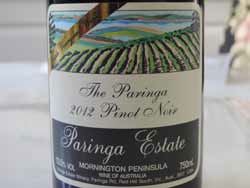 2012 Paringa Estate The Paringa Single Vineyard Mornington Peninsula Australia Pinot Noir 13.5% alc.. 25th vintage from this winery founded in 1988. One of the most awarded wineries in Australia for Pinot Noir and Shiraz, owner and winemaker Lindsay McCall manages 55 acres of vineyards for Paringa Estate, producing about 15,000 cases of wine annually. · Moderately light garnet color in the glass. Nicely perfumed with aromas of cherry, spice and oak. The mid weight core of dark cherry fruit has an appealingly earthy underpinning. The tannins are balanced and there is some finishing verve. This inviting wine had even more cherry and spice presence two days later from a previously opened and re-closed bottle. Score: 91
2012 Montalto Vineyard Single Vineyard Main Ridge Block Mornington Peninsula Australia Pinot Noir 13.1% alc.. Clone D5V12 planted in deep red volcanic soils. Wines are produced from 6 vineyards across the Mornington Peninsula including Main Ridge, the highest and coolest site. · Moderate reddish purple color in the glass. I love the nose that fills the glass with aromas of perfectly ripened cherries, raspberries and spice. Very smooth and seductive on the palate with pleasingly vivid flavors of black cherry and plum. Well-structured for the long haul, with a finish that has a vibrant, mouthwatering fruit presence that lingers endlessly. Score: 93-94
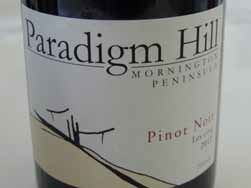 2012 Paradigm Hill Les cinq Mornington Peninsula Australia Pinot Noir 13.8% alc, pH 3.69, TA 0.67.Clone 115. Harvest Brix 24.5º. 4-day cold soak, 5-day fermentation, 6-day post maceration. Aged 18 months in 33% new French oak barrels. Winemaker is George Mihaly. · Moderately dark reddish purple color in the glass. Enticing scents of cherry, plum and rose petal lead to a mid weight attack of tasty plum, dark cherry and dark raspberry fruits that hint at a bit of confection. Very charming with balanced tannins and some finishing length. Delicious two days later from a previously opened and re-closed bottle. Score: 92
Two more aged treats from Eldridge Estate:
2006 Eldridge Estate Single Clone MV6 Mornington Peninsula Australia Pinot Noir 14.0% alc.. · Moderately light reddish purple color in the glass with no sign of aging. Fresh and bright aromas of cherry and red plum initially, fading a bit in the glass over time with more oak showing up. Light to mid weight flavors of cherries and raspberries with a hint of spice and mushroom. Very elegant with supple tannins and some finishing length. Drinking beautifully now, but will hold a few more years. Score: 90
2008 Eldridge Estate Single Clone MV6 Mornington Peninsula Australia Pinot Noir 13.6% alc.. · Moderately light reddish purple hue in the glass. Somewhat shy aromas of darker cherries and raspberries. Pleasing middleweight flavors of black cherry and plum with an earthy, savory underpinning. The tannins are fine-grain, the oak plays a flattering role, and the fruit-driven finish lasts and lasts. A charming wine with impressive harmony. Will easily last another 10 years in the cellar. Score: 92
2010-2012 ABV of California & Oregon PNOAs I have written previously, alcohol in wine is a seducer with a punch. It stimulates the appetite, offers gustatory pleasure, and leads to relaxation, more social interaction and even procreation. Alcohol contributes body, texture, intensity and sweetness that makes fruit in wine seem fuller and broader. Since alcohol is a solvent, it can extract more flavor out of skins, pips and oak barrels. It is a critical factor in wine balance which in turn is an important feature that determines wine quality. Dr. Bruce Zoecklein, Head, Enology-Grape Chemistry Group at Virginia Tech, has discussed alcohol and balance in several of his Enology Notes published online at www.vtwines.info/. He states, “Palate balance is a critical feature influencing wine quality. The major factors governing palate balance in dry wines are the quantity and “quality” of tannins, concentration of alcohol, and concentration and types of acidity. A wine with a high phenolic load (something the wine industry has focused on resulting in a higher sugar per berry concentration) is frequently in better balance with both a lower acidity and higher alcohol content.” It is well documented that alcohol levels in wine have risen significantly over the last few decades. Data from the Alcohol Tobacco Tax and Trade Bureau (TTB) indicate that the quantity of higher alcohol wines produced in the United States over the last decade increased 50% on a relative basis to 9% of bottled still wines. Despite its allure, and the happy buzz that accompanies its ingestion, alcohol can be devilish. At higher levels, it suppresses fruit aromas on the nose by secluding aroma molecules, preventing them from being released into the air. Alcohol has no taste per se, but it can overpower the palate, preventing recognition of the varietal, obscuring the perception of phenols, lowering the perception of nuances and thus complexity in wine, and disguising terroir by obscuring flavors. At levels of 15% or more in wine, alcohol can cause a burning sensation in the nostrils and create a sense of bitterness and heat on the finish. High alcohol wines have become the bane of many sommeliers who find it can disrupt balance in wine, diffuse the taste buds, and create an undesirable amplification of certain elements in a dish. Outspoken sommeliers have caught the ire of some notable winemakers whose wines often clock in at the upper ranges of alcohol percentage including Helen Turley, who crafts popular Chardonnay and Pinot Noir wines at Marcassin. She has called this cadre of sommeliers who reject higher alcohol wines “Dim Somms,” and this has created quite a stir among the wine community. The best commentary on this ongoing feud was posted by the HoseMaster of Wine in his blog at http://www.hosemasterofwine.blogspot.com/2014/09/ipob-attacks.html Hilarious! A majority of the wine-drinking population is unfazed by higher alcohols in wine, and usually do not consider alcohol percentage by volume (ABV) when picking a wine. This is largely a result of genetics. 50% of the population have one dominant and one recessive gene for taste and are termed “regular” tasters. As a group, these wine drinkers choose moderate flavors and are only mildly sensitive to tannin, sugar and high alcohol. I canvased the ABV of all California and Oregon Pinot Noirs from the 2010, 2011 and 2012 vintages that have been reviewed in the PinotFile to date. Each vintage is presented in a bar chart below. Remember that ABV is not an exact figure. A study reported in Wines & Spirits (Fall 2010), found that 10% of the wines tested significantly exceeded the legal boundaries, indicating that wines can have significantly more alcohol than the stated ABV on the label. The ABV on the label is not required by the TTB to be accurate because a range of tolerance is permitted. Wines of 14% alcohol or less are allowed a 1.5% margin of error, and wines over 14%, a 1% margin of error. Therefore a wine that is 12.5% alcohol, may be labeled anywhere from 11.0% to 14.0% alcohol, and a wine labeled 15.0% might be anywhere from 14.01% to 16.0% alcohol. A wine with more than 14.0% alcohol cannot be labeled as containing less alcohol and vice versa. The ABV values used in this survey are primarily from the percentage stated on the label. Labels are often printed before a wine is bottled and released, so that the label ABV may not be the same as the final in bottle ABV stated on the winery’s tech sheets. On the charts below, the x axis represents the number of wines and the y axis the ABV range.
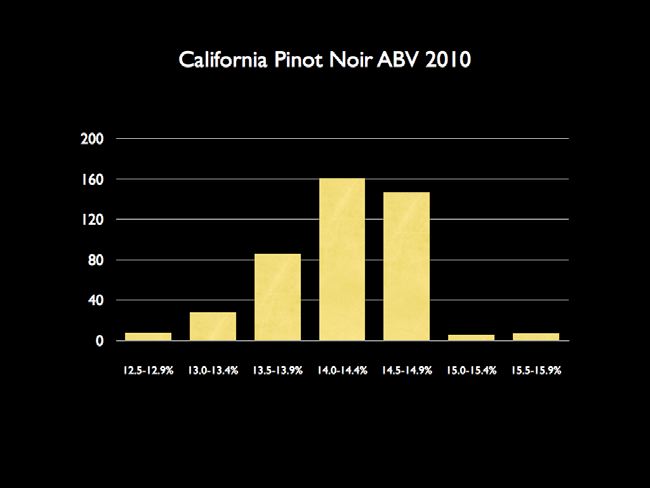
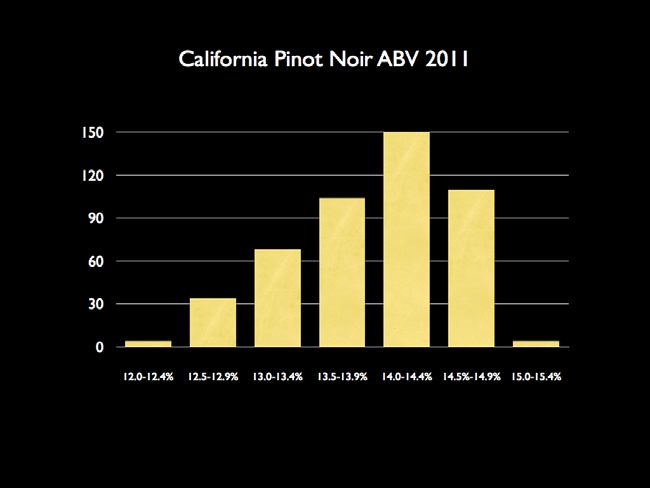
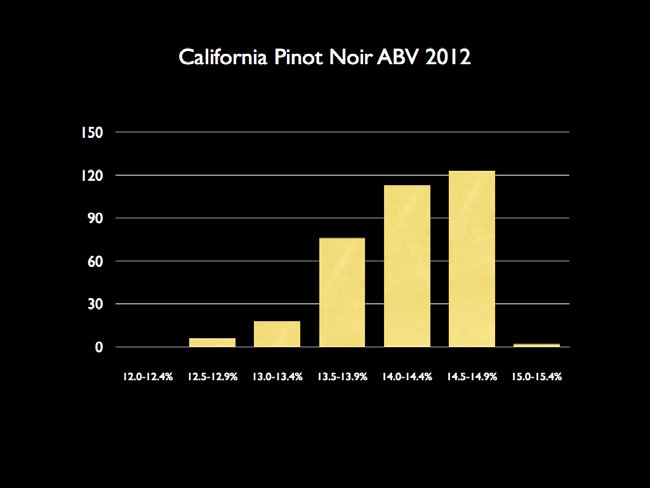
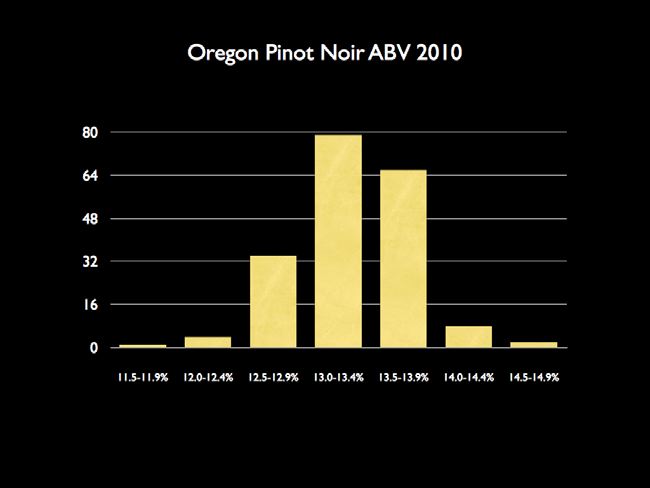
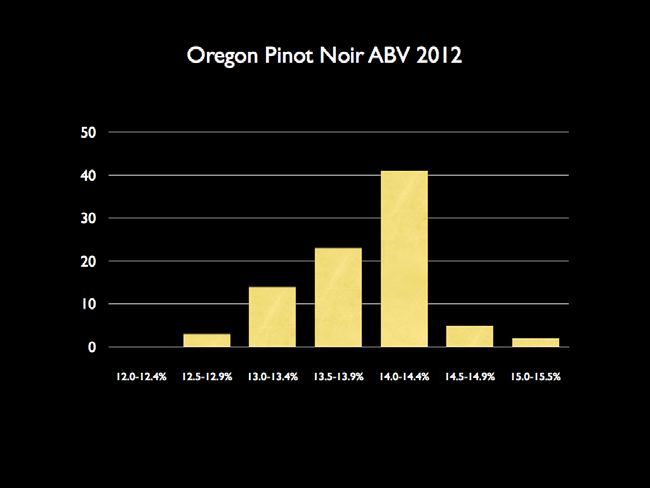
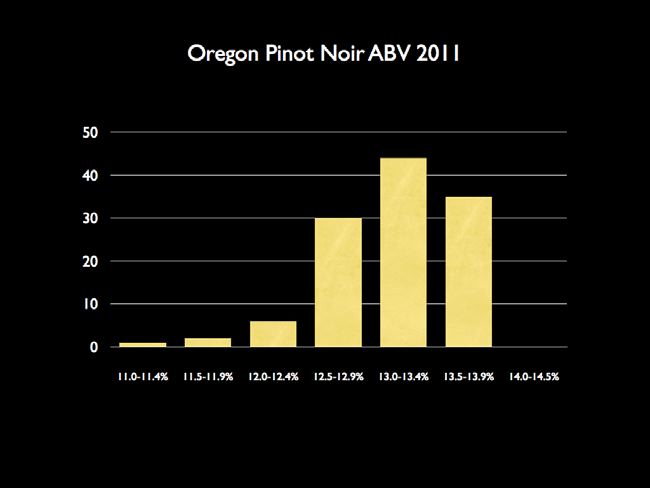 What information can be gleamed from this survey? ** The range of Pinot Noir ABV by vintage:
** California Pinot Noir ABV was predominantly in the 14.0%-14.9% range with 70% of the wines in this range in 2010, 55% in the cooler 2011 vintage, and 78% in the warmer 2012 vintage. A significant number of wines were at or above 14.5% and since winemakers often downplay the true ABV, and given the 1% leeway above 14.0% ABV, it is easy to speculate that a number of these Pinot Noirs were over 15% alcohol. ** Oregon Pinot Noir ABV was predominantly in the 13.0%-13.9% range in the cool 2010 and 2011 vintages (75% and 67% respectively). In the warmer 2012 vintage, only 45% of the wines were in the 13.0%-13.9% range, while 53% of the wines were in the 14.0%-14.9% range, although overwhelmingly in the 14.0%-14.5% range. Oregon shows more vintage variation in grape ripeness and resulting ABV in the finished Pinot Noir wines.
Do alcohol levels in Pinot Noir matter? Well, higher alcohol Pinot Noirs will surely get you sideways a lot quicker, but is that the goal? ABV does matter when you are looking to drink in moderation. A bottle of Pinot Noir at 15% ABV contains 15% more alcohol than a bottle of wine containing 12% ABV. One should consider scaling back the volume of wine drunk when imbibing a wine with a higher alcohol percentage (above 14.5%), or reach for a lower alcohol wine to insure that you stay within the confines of moderation and avoid the damaging health risks associated with heavy alcohol intake. A new two-minute medical video encouraging healthcare professionals to talk with patients who drink alcohol about the importance of moderation will begin airing this month in thousands of physicians’ offices, acute care hospitals and military facilities across the country. The news report provides healthcare professionals and their patients with important science-based information on alcohol and health from the U.S. Dietary Guidelines and the Centers for Disease Control and Prevention. The news video emphasizes the Dietary Guidelines definition of moderation as up to one drink (5 ounces of wine) per day for women and two drinks per day for men. The video news report can be viewed at the following link: https://www.youtube.com/watch?v=RgV2BZHGHxQ I have been a long time proponent of listing ABV on wines I review in the PinotFile, and I believe I was the first wine publication to implement this practice on a consistent basis. Unfortunately for the consumer, the ABV is often presented on a wine label in very small print (only 0.5 mm font size is required) and in some cases in a poorly contrasting color, so that it is virtually unreadable without a magnifying glass.
Pinot Briefs‘Sideways’ Ten Years later Santa Barbara County is still feeling the significance of the movie ‘Sideways’ and local businesses are still promoting it. You can plan a film tour of Santa Barbara at www.santabarbaraca.com, where a self-guided tour brochure is available that spotlights locations from the feature film. A 10th Anniversary screening of the movie will be at the historic Arlington Theater on State Street in Santa Barbara on September 28. Share your ‘Sideways’ tips, tweets and photos by using the hashtag #Sideways10 on Facebook, Twitter and Instagram.
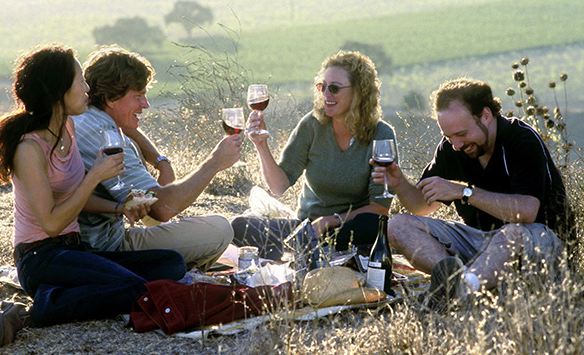 Winery Geek App This mobile App has a huge database of more than 2100 California Wineries and tasting rooms. It allows one to search wineries by varietals poured or winery amenities, and includes discount coupons, maps, directions, pictures and videos. Available free for iPhone or android systems at the Apple iTunes store.
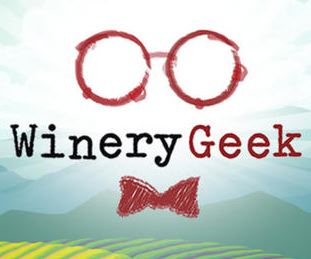 Wine Science Extra Jamie Goode has just published a e-book companion to his book, The Science of Wine. The revised version of The Science of Wine was published this year but some material could not be included. The Wine Science Extra is a collection of chapters covering some interesting topics in wine science that form a supplement to the hard bound book. Chapters are included on global warming and its implications for viticulture, naturalness in wine, corks, screwcaps and alternative closures, wine allergies, extending lifespan by drinking wine, and the future of wine science. It is available as a downloadable pdf or via Kindle for $9. Willamette Valley is Place if You Still Want Into the Pinot Noir Game I was perusing some listings of vineyard homes and wineries for sale in the Willamette Valley and was astonished how affordable these properties still are. One example is a 32.8-acre property in the Eola-Amity AVA with 17 acres of mature vineyard, a custom cottage and outbuildings for $1.3 million. Another example is a 40-acre estate with 12 acres of Pinot Noir and Pinot Gris, architect designed home, guest quarters, studio, office, shop, and 8 16 additional plantable acres all for $2.4 million. Visit www.oregonvineyardland.com or www.oregonvineyardsandwineries.com, and swoon over the possibilities. Moshin Vineyards Celebrates 25 Years When the Moshin family harvested their first fruit from a 10-acre vineyard on Westside Road in the Russian River Valley in 1989, several tons were sold to Davis Bynum Winery where Rick Moshin was custom crushing his inaugural vintage under the Moshin label of a few hundred cases. Since then, the vineyard holdings have increased to 28 acres, case production is up to 8,000 cases annually, and a thriving 4-tier gravity flow winery and tasting room is staffed by 20 team members. Moshin Vineyards is celebrating this occasion with a special 25% discount on all case purchases of all wines during September. Use promo code 25ANNV on the winery’s website at www.moshinvineyards.com. Three Sticks Winery Opens The Adobe Renovation of this historic Vallejo-Castenada Adobe has been completed and will be the new home of Three Sticks in downtown Sonoma. The building was constructed in 1842 for Captain Salvador Vallejo and is one of the few remaining buildings from California’s Mexican period. Tasting appointments are available by reservation. Visit www.threestickswines.com. Knudsen Vineyards Releases First Wine in Almost 40 Years The adult children of Oregon wine pioneer, Cal Knudsen, have revived the Knudsen name in winemaking, and are releasing the 2012 Knudsen Vineyards Dundee Hills Pinot Noir. Cal and Julia Lee Knudsen acquired a 200-acre property in the Dundee Hills in 1971, and partnered with Dick Erath to plant Pinot Noir and Chardonnay. Dick built a home and winery next to the Knudsen Vineyard. In 1975, Knudsen Erath became the first bonded winery in Dundee Hills region. After the 1987 vintage, Cal and Dick dissolved their partnership with Knudsen Erath becoming Erath and Cal retaining ownership of the vineyard. Knudsen Vineyards became the major source of grapes for Argyle Winery and until recently, all the vineyard’s grapes went to Argyle. The new Knudsen Vineyards Pinot Noir ($55) was crafted by Nate Klostermann, the winemaker at Argyle Winery and is highly allocated through a mailing list at www.knudsenvineyards.com. A Chardonnay will be released in 2015 and possibly sparkling wine thereafter.
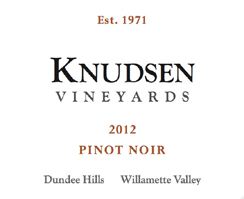 EARLY Harvest Throughout California; Earlier Harvest in Oregon: The growing season began with a very mild winter with nothing to hold back the vines from pushing out new growth. Budbreak was common in early March and even, warm temperatures throughout the spring and summer led to accelerated development and an early harvest. The first grapes were harvested in Santa Barbara County on August 25, the earliest date on record in Santa Barbara County. Drought has not generally been a factor, and crop size is normal to slightly above normal for most vineyards. Conditions have been perfect in the Willamette Valley so and harvest is begun already for white wine grapes with Pinot Noir not far behind. Oregon’s hot summer and mild conditions for ambient yeast on the grapes led to an early harvest. Santa Barbara Vintners Celebration of Harvest Four days of wine and food comes to Santa Barbara Wine Country for the 23rd Annual Celebration of Harvest Weekend, October 10-13. A Vintner’s Visa is offered for $50 a person that provides a tasting pass for the weekend at your choice of up to 12 different wineries and tasting rooms from the list of 50 participants. The Festival Grand Tasting will be on Saturday, October 11, at Old Mission Santa Inés, with nearly 120 winery members of the Santa Barbara Vintners pouring at the largest tasting of Santa Barbara County wines of the year. Tickets start at $75 per person with upgrades slightly more. Visit www.celebrationofharvest.com. Ground Boots Pinot Noir: A Charitable Wine Brand Winemaker Deborah Hall of Gypsy Canyon in the Sta. Rita Hills AVA and artist Donald Roller Wilson have joined forces to launch a charitable brand called “Ground Boots.” Hall will donate 100% of proceeds of each bottle of Ground Boots Pinot Noir to nonprofit charities. The first year, the Ground Boots Pinot Noir will benefit Soi Dog Foundation that helps the homeless, neglected and abused dogs and cats of Thailand and works to end the dog meat trade throughout the region. In January 2015, Hall will return to Thailand to work with Soi Dog. 100 cases will be released each year, at a $70 per bottle cost. As a charitable negociant, Hall will purchase the wine herself from some of Santa Barbara County’s best winemakers and create the final blend for inclusion under the Ground Boots label. The first released on September 15 will be the 2012 Santa Barbara County Pinot Noir. The label art work for Ground Boots was donated by the world famous and widely loved artist, Donald Roller Wilson. His art is said to be a cross between William Faulkner and Dr. Seuss with a bit of the Old Testament. To learn more, visit www.groundboots.org.
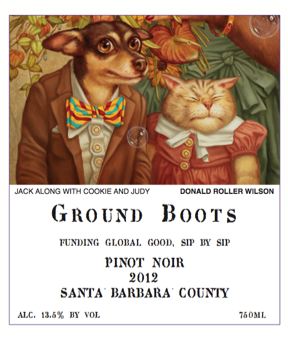 Pinot On The River The 11th Annual Russian River Valley Pinot On The River will be held on the Healdsburg Plaza Sunday, October 26, from 11:00 AM to 4:00 PM. 100 wineries will be pouring currently released and library Pinot Noir at this event which benefits the Boys & Girls Clubs. Tickets are $75 in advance, $100 at the door. Visit www.pinotfestival.com. Moderate Wine Drinking + Exercise = Health Benefits A current trial called In Vino Veritas was reported at the European Society of Cardiology annual congress in Barcelona. It is one of the first studies to introduce wine into people’s lives and track its effects on their bodies. Researchers found that moderate wine drinking was only protective in people who exercised, with red and white wine producing the same results. Among subjects who worked out twice a week and drank wine, there was significant improvement in good cholesterol and decreased levels of bad cholesterol after a year of wine. The study concluded, The combination of moderate wine drinking plus regular exercise improves markers of atherosclerosis (hardening of arteries) suggesting that this combination is protective against cardiovascular disease.” Union Wine Releases Videos Poking Fun at Wine Pretentiousness Union Wine in Oregon sells Pinot Noir and Pinot Gris in 12 oz cans. They have released a series of very humorous ads that poke fun at wine snobs. The videos carry the tagline “wine doesn’t have to be this hard,” followed by the hashtag #pinkiesdown. View the videos at https://www.youtube.com/watch?v=QPKTLmee9zc. Architectural Winery Marvels An article called “Architectural Marvels: 9 Temples to Wine in Napa and Sonoma” was published online at www.wheretraveler.com/san-francisco/your-guide-architecture-northerncalifornias- wine-country. Wineries featured in Sonoma County were Buena Vista Winery, Kosta Browne Winery, Ram’s Gate Winery, and Williams Selyem. The photographs are beautiful. West of West Comes to Orange County, California West Sonoma County Vintners is an association of wineries and winegrowers dedicated to preserving and protecting the history, landscape and culture of the West Sonoma Coast. The organization’s West of West Festival is held annually in early August in Sebastopol, California, with additional West of West Festivals celebrating the wines of the West Sonoma Coast in other major cities in the United States. This year, a West of West Festival will be held at the Anaheim Honda Center in Orange County, California. Wineries will be pouring their West Sonoma Coast wines and Orange County’s top restaurants will be providing pinot-friendly bites. West Sonoma County Vintners includes the following notable producers: 32 Winds Wine, Ceritas Wines, Claypool Cellars, CrossBarn by Paul Hobbs, DuMOL, Emeritus Vineyards, Failla Wines, Flowers Vineyard & Winery, Freeman Vineyard & Winery, Gros Ventre Cellars, The Hartford Family Winery, Hirsch Vineyard & Winery, Holtermann Family Wines, Joseph Phelps Vineyards, La Pitchoune Winery, Lattanzaio Wines, Littorai Wines & Estate Winery, Martinelli Winery, Peay Vineyards, Ramey Wine Cellars, Red Car Vineyards, Senses Wines, Small Vines, Soliste, Sonoma Coast Vineyards, Wayfarer Vineyard and Zepaltas Wines. Tickets go on sale September 22: check back for details or visit the West Sonoma County Vintners website at www.westsonomacoast.com.

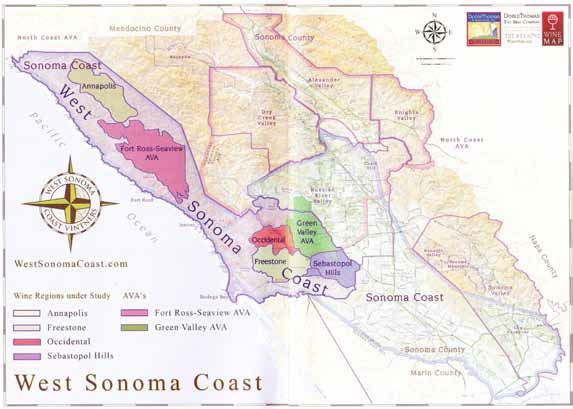
Winemaker Up Close & Personal: Scott Rich, Talisman Wines
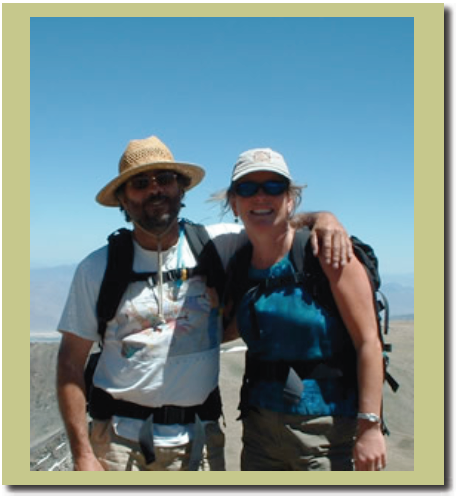 What Pinot Noir made by someone else I am drinking now: 2011 Calera Reed Vineyard Pinot Noir - Delicious! My desert island wine would be: Didier Dagueneau Silex - it’s refreshing enough for that environment. My talent that few know about: Hawaiian nose humming. The thing I do religiously in my winery: Remember how lucky I am to have my life. The clothing item I wear most in my winery: Assorted t-shirts. The wine region other than my own where I would like to make Pinot Noir: An unplanted special little hillside in New Zealand that I believe is their closest thing to the Cote d’Or. I found it there on a trip in 2011. The music I am listening to: Red Hot Chili Peppers - “By the Way.” I like to relax by: Surfing and playing guitar very poorly. If money were no object, I would: Clean up the plastic-laden Great Pacific Gyre. If I wasn’t a winemaker, I would be: A very poor artist. Photo above is of Scott and his spouse Marta |